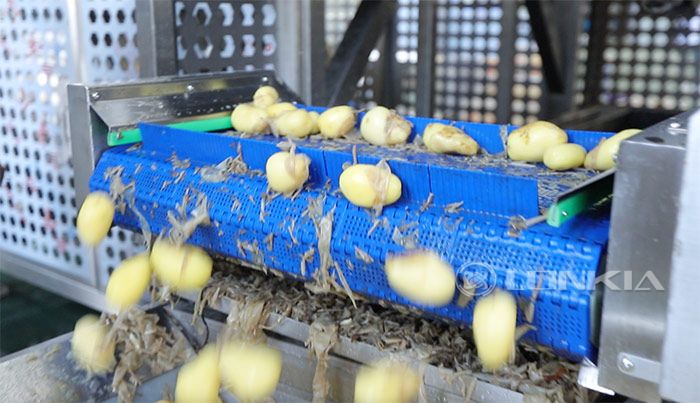With the rise of fast food culture, potato fries have become a star product in the fast food industry, leading to a growing market demand. To meet this demand and ensure synchronized improvements in product quality and output, potato fries manufacturers need to consider introducing more advanced production equipment to expand their production and capture market share. This article will detail how the introduction of steam peeling machines, Hydraulic Cutting Blade System, and other advanced equipment can construct efficient and high-yield potato fries production lines.
Steam Peeling Machine: Enhancing Raw Material Processing Efficiency
In the process of potato fries production, raw material processing is crucial. Traditional peeling methods are inefficient and struggle to ensure uniformity and cleanliness, often damaging potatoes and affecting subsequent processing and product quality. The introduction of steam peeling machines addresses these challenges.
Steam peeling machines use high-temperature steam to soften the potato skins, making them easy to peel, with a capacity of processing 1 ton of potatoes per hour. This method significantly enhances peeling efficiency, reducing raw material waste and damage compared to traditional methods, which can have loss rates as high as 30%, reduced to 4-7%. Potato fries manufacturers can swiftly process raw materials using steam peeling machines, ensuring ample supply for subsequent cutting, frying, and other processes.

Hydraulic Cutting Blade System: Precision Cutting in Large Volume
Processed potatoes require cutting to achieve standardized fry shapes. Hydraulic Cutting Blade System, as efficient and precise cutting equipment, play a crucial role in potato fries production.
Potatoes are fed into enclosed cutting chambers with circulating water, propelled through customized stainless steel blades by a pumping mechanism, enabling precise cutting. This equipment operates autonomously, completing cutting and discharge tasks without manual intervention. It not only enhances production efficiency but also ensures fry consistency. Hourly production rates can reach up to 9 tons, easily meeting large-scale production demands.
By introducing these advanced equipment solutions, potato fries manufacturers can:
Increase Production Efficiency: High levels of automation allow continuous production, significantly boosting efficiency. This means manufacturers can produce more fries within the same timeframe.
Ensure Product Quality: Equipped with precise control systems and high-quality cutting tools, the equipment ensures every fry is cut to uniform dimensions. This enhances visual appeal and consistency in taste after frying, improving overall product quality.
Reduce Production Costs: While initial investments in advanced equipment may be higher, they lead to long-term cost reductions. Automation reduces labor costs, while increased production efficiency and reduced waste enhance raw material utilization. Additionally, the equipment's high reliability and low maintenance costs contribute to overall operational cost savings.
Expand Production Scale: With improved efficiency and assured product quality, manufacturers can confidently expand production scale. Simply increasing equipment uptime allows them to meet growing market demands.
Introducing these highly automated, high-yield advanced equipment solutions into production lines can revolutionize potato fries processing. They not only significantly boost production efficiency and reduce labor-intensive tasks and errors but also ensure consistent delivery of high-quality fry products. This expansion enhances potato fries manufacturers' competitiveness and profitability, providing greater economic benefits."
